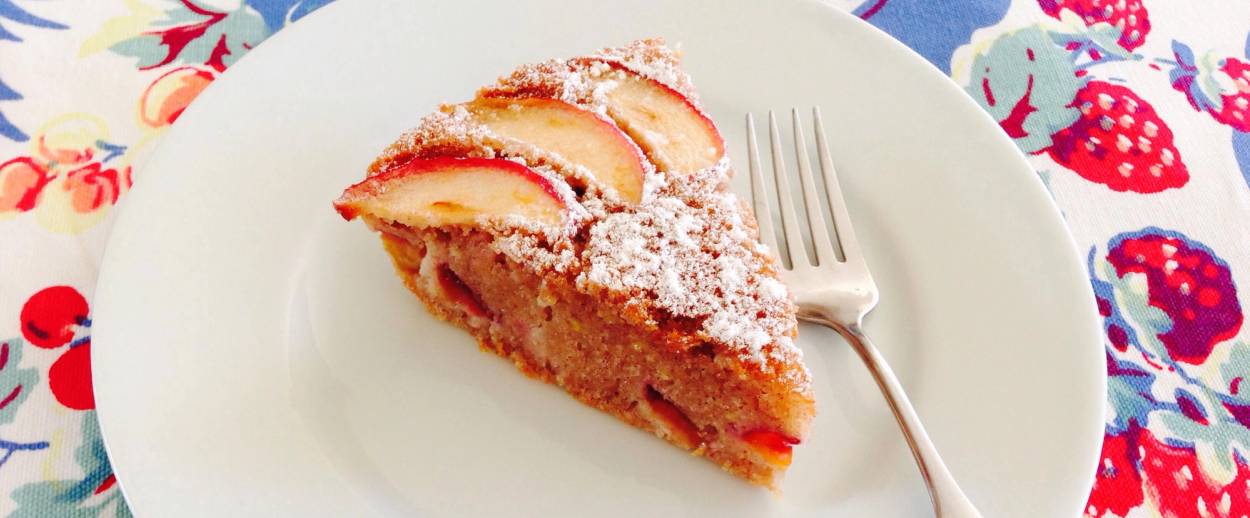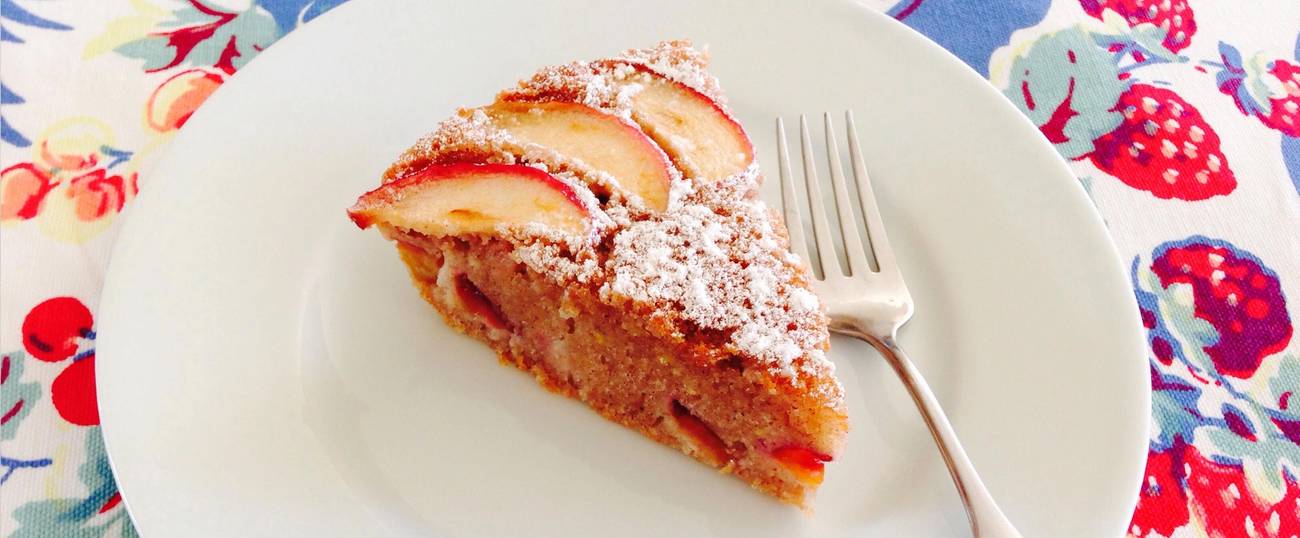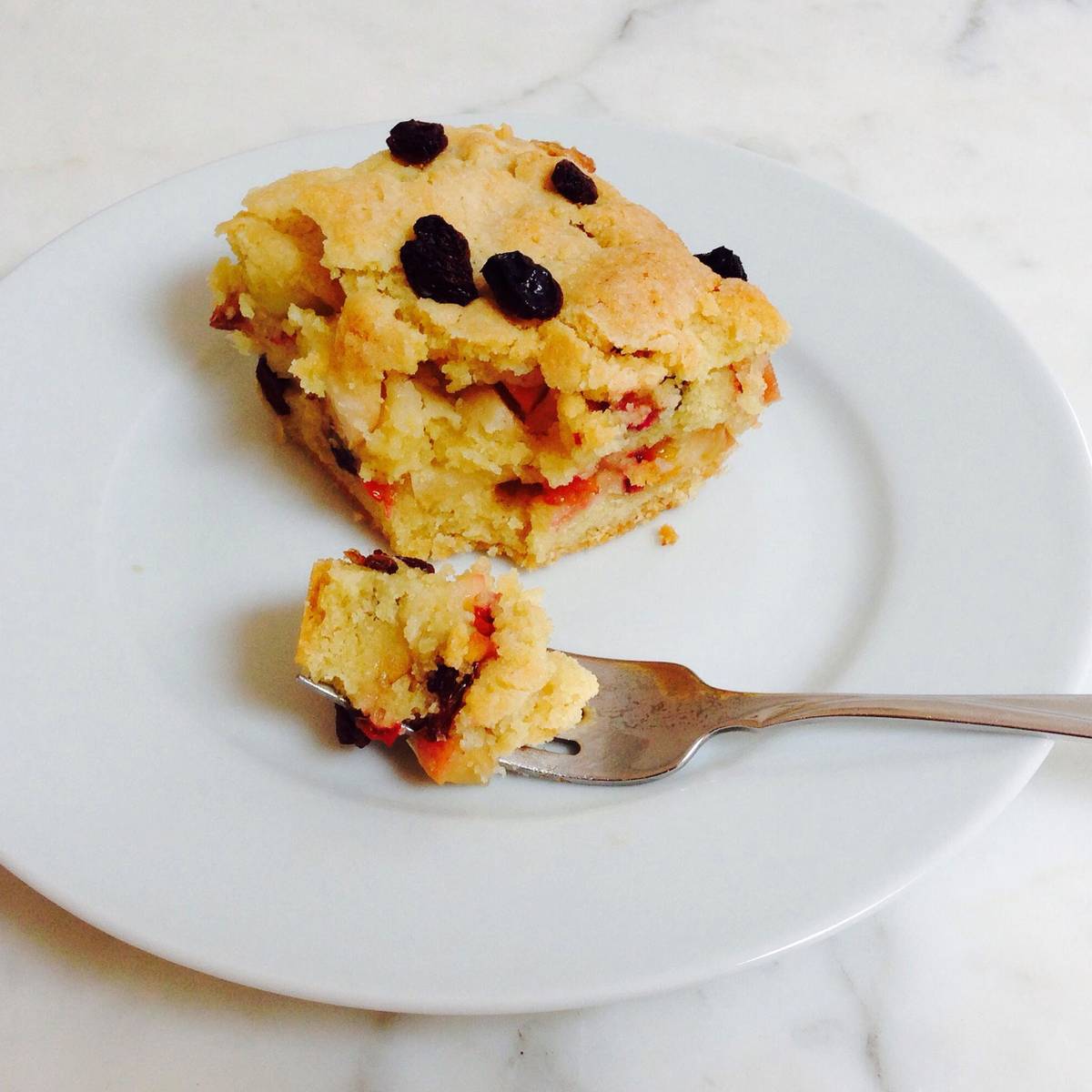Not Quite My Great-Grandmother’s Apple Cake
When I tried making a treasured family recipe, I decided it needed some revisions. This Rosh Hashanah, I’ll honor my great-grandmother by updating her recipe.




My mother came to visit me this summer without a real sense of what she was getting into. We would be spending a week on the farm that my husband and I bought a year ago—an old, sagging barn, a wide open field, and 35 fruit trees on a little island in the Pacific Northwest. It was late July, and the Italian plums were just ripe. When my mother offered to help, we quickly put her to work.
We went out together, boxes in hand. My son climbed up into the tree’s strong branches while the rest of us fanned out around the trunk, each finding our own territory. With her arms up-stretched to the sky, her palms cradling the oblong, aubergine, oblong fruits, my mother’s tall, lean frame nearly disappeared in the thick of the leaves.
“This is a long way from Afula!” my mother said, laughing, her face completely obscured. Afula was where my great-grandfather bought a piece of farmland in the 1920s as part of the Zionist effort to create the new Jewish state. My grandfather—his son, and my mother’s father—spoke of Afula often, but no one in the family ever lived there. My great-grandfather, a dentist, had bought the land as an investment; he lived in Poland and never intended to leave Europe. And my grandfather, though he studied agriculture in France for the purpose of helping build the new state of Israel, fled Europe shortly after his graduation in 1937. The visa he was able to obtain sent him to America, where he never put his agricultural skills to use: He was married for a very short time to the daughter of an apple magnate in upstate New York, then moved to Cleveland, where he owned an umbrella shop for the rest of his working life.
I think of my grandfather often when I am out in the trees. I think of the ways life turns and fates intervene, and of the places we feel tethered to by deep and mysterious threads. On the one hand, I know we have inherited these trees from two very specific people: Barney and Marguerite Goodrow, who bought this land in 1939 and lived here happily until Barney’s death in 2004. These trees were Barney’s pride and joy, and it is his life’s work that we are responsible for now, that we will steward into the future. In another more mystical sense, I feel that I am here because these trees called to me.
Between the branches I saw my mother eating a plum, its chartreuse flesh in her hand giving her away. “I’ve never even liked plums,” she said, devouring the other half and dropping the pit at her feet. She was having fun, steady at the task, taking fruit from my son, who handed plums down to her delicately.
But there were too many plums to eat out of hand. This tree alone would produce 100 pounds, and there had been three other plum trees ripe before this. Soon the apples would come full-force. Already we’d had the early-season Yellow Transparent, a pale-skinned, soft-fleshed variety from Eastern Europe. This year we harvested them by moonlight, my husband and I out in the field together after our son had gone to sleep, the yellow, thin-fleshed apples shining like pale planets after dusk. Next came 120 pounds of Williams Pride, Gravenstein, and Akane. A tree whose variety we don’t even know produced 80 pounds alone before September began, and another 1,000 pounds of fruit still hangs on the trees.
From the fragrant Shiro plums to the soft-skinned apricots, the strange green figs and the sour cherries, all this fruit has demanded as much attention in the kitchen as in the field. Even allowing for the fruit we give away, sell to the bakery, or process into jam and sauce, chutney and pie filling, there is still a lot of fruit left over for eating and baking. Whole wheat apple muffins, Viennese plum cake, peach pie, fig galette, apricot financier, and apple-blackberry crumble have all come out of my kitchen at least once this year.
I’ve had to expand my repertoire of recipes to deal with the pace of the fruit we’re producing, and the sheer quantity has made each attempt less precious, more of an adventure. So it was that I returned to my grandmother’s recipe book and found my great-grandmother’s apple cake—Mother’s Apple Cake, as it’s written in my grandmother’s hand. I don’t remember my grandmother ever making this cake, so I asked my mother. “I think it was dry,” she said with a frown.
I realized in that moment that I knew nothing of my great-grandmother. “Her name was Norma,” my mother said, “and she had the most amazing white hair. She was very stylish. The other women would wait until she had picked out her fabrics and cuts for the season, and then they would buy what she bought. She was a trendsetter!”
Maybe my grandmother only made this cake when her mother was alive and then retired it in favor of the more basic honey cake I remember at holidays. But there’s hardly an apple recipe I won’t try these days, and it’s another way to hold onto this life, a life of my elders, their real and imagined homes that I barely knew. So I decided to make Mother’s Apple Cake.
This recipe of my grandmother’s was no different from her others: It was not flush with specifics.
Mother’s Apple Cake
Mix 3 cups flour, 2 teaspoons baking powder and 1/2 teaspoon salt
Add 1 cup sugar, 3/4 cup oil, 2 eggs and 1 yolk, 1 teaspoon vanilla
Divide into 3 parts, roll and cut to fit pan. Fill with apples, plums, raisins, and jam on each layer. Cut into squares. Pour a little butter or oil between the rows
Bake at 350 until brown
But the ingredients were simple enough, and I was delighted to see that it called for plums; we still had three heavy boxes in the fridge. The dough was firm and strange, the consistency of marzipan, and it would not roll out. (Maybe it needed to be refrigerated for an hour or so.) So I used handfuls of flour, rolled and cut and transferred it in messy pieces to the square dish. My son sprinkled raisins while I lay the fresh fruit in the dough. I skipped the recipe’s jam, which seemed like overkill with our good produce. Instead, another sprinkle of raisins went on top.

I had tasted the raw dough and it was sweet and good, but I didn’t think it was going to cook through. Forty-five minutes later it had risen and hardened and browned just as my grandmother’s notes said it would. But it wasn’t pretty. To put it in perspective, my sweet-toothed son refused to try it.
I, on the other hand, was so anxious to take a bite that I hardly let the cake cool; even warm, it cut cleanly and came out of the pan without trouble. The top was almost crunchy and the interior was soft—not cake-like but soft, like a damp shortbread cookie. The first bite was totally uninspired. “I’m not sure this is good,” I said to my husband, and then took another bite. “It is a bit dry…” Bite. “But I like that it’s not too sweet…” Bite, bite. “You really taste the fruit…” Bite, bite, bite. “It’s almost more like a cookie, with fruit, and…” Clean plate.
All of which is to say, this cake grew on me. But for a cake that’s meant to be served on Rosh Hashanah, the holiest of holidays, I thought I could do better.
What I liked from my great-grandmother’s recipe was the layered aspect of the fruit and cake, and the combination of plums and apples. But the square pan, while traditional for Eastern European fruit cakes, felt quotidian. And when I hear “cake,” I want cake, not a cookie masquerading as a cake.
My grandmother always taught me that in cooking, you can improvise, but in baking, you shouldn’t mess around. Follow the recipe; baking is a science. But I had to take that with a grain of salt. She herself baked with a little of this, a little of that, and substituted along the way to use what she had on hand. So I went back to a recipe for a financier I’d baked recently with the summer’s crop of apricots, and I made a few changes. I made a sweet cake batter using almond flour, cinnamon, and lemon zest; I layered chopped plums in the dough like little gems; and I arranged the apples around the top. I skipped the raisins entirely, and I didn’t miss them for a minute, but it certainly wouldn’t hurt to add them back in. A ceramic pie dish with an elegant fluted edge felt much more festive to me than the old square pan.
I don’t know that I’ll ever make my great-grandmother’s apple cake again, but maybe this new cake (recipe here) will honor her by starting a new trend.
Margot Kahn is a writer-in-residence with Seattle Arts & Lectures and the author of the biographyHorses That Buck: The Story of Champion Bronc Rider Bill Smith.